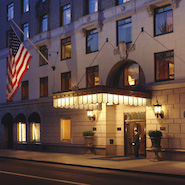 Exterior of The Ritz-Carlton New York, Central Park
Exterior of The Ritz-Carlton New York, Central Park
The Ritz-Carlton Hotel Company is the top hotel brand for guest satisfaction, according to J.D. Power’s 20th North America Hotel Guest Satisfaction Index.
While improvement in overall satisfaction was minor, the luxury segment saw much more encouraging numbers, with Ritz-Carlton’s 896/1,000 rating leading the pack for the second year in a row. As what consumers once understood as “perks” have become expected, the high level of service offered at luxury hotels has emerged as the primary distinction of satisfying stays.
"Luxury hotels still often charge for WiFi and rarely give free breakfast," said Rick Garlick, travel and hospitality global practice lead at J.D. Power. "However, this trend is changing as even high end hotels now frequently provide wi-fi for no additional charge, particularly if you are part of the loyalty program.
"This is another contributor to enhanced value in the luxury segment," he said. " Perhaps ‘free’ breakfast is something they can roll into the overall rate, as European hotels frequently include breakfast as part of the rate package.
"Finally, service adds value for guests. While most luxury hotels provide outstanding service, it is sometimes inconsistent. Creating a strong service culture is a way to continually add value for the guests; I believe enhanced service training is already reflected in the increased value scores this year."
Kept satisfied
The study divided categories into luxury, upper upscale, upscale, upper midscale, midscale, economy/budget, upper extended stay and extended stay categories. Nearly all hotels categorized as luxury outperformed even the highest ranked brands in other segments, showing that with hotels, you really do get what you pay for.
Following the top-ranked Ritz-Carlton, Four Seasons placed second with a score of 882, while JW Marriott and Waldorf Astoria scored 874 and 869, respectively. The luxury average was 869, while Fairmont scored 860 – still higher than every non-luxury option except for upper midscale chain Drury and upper extended stay Home2 Suites by Hilton.
 Four Seasons Los Angeles at Beverly Hills
Across all categories, satisfaction only increased by two points from 2015 to 2016, largely due to a mere one point improvement in costs and fees compared to 25 the prior year. However, the luxury segment reversed the trend, seeing a 20 point improvement in cost and fees and a 12 point improvement overall.
This contrast is likely in part due to the all-inclusive pricing model that luxury hotels have been adopting in recent years. Rather than booking the room, then paying for airport transfers, WiFi, breakfast and other amenities, the advertised price includes all these services.
Luxury hotels also benefit from the increased desire for “luxurious beddings and linen,” now the fourth most important amenity after complimentary WiFi, breakfast and parking.
Among the opportunities the study found for brands is online or mobile check-in. Only 3 percent of guests use it, but check-in/check-out satisfaction rates are highest among those users. Advertising or incentivizing mobile check-in could lead to higher satisfaction rates.
Four Seasons Los Angeles at Beverly Hills
Across all categories, satisfaction only increased by two points from 2015 to 2016, largely due to a mere one point improvement in costs and fees compared to 25 the prior year. However, the luxury segment reversed the trend, seeing a 20 point improvement in cost and fees and a 12 point improvement overall.
This contrast is likely in part due to the all-inclusive pricing model that luxury hotels have been adopting in recent years. Rather than booking the room, then paying for airport transfers, WiFi, breakfast and other amenities, the advertised price includes all these services.
Luxury hotels also benefit from the increased desire for “luxurious beddings and linen,” now the fourth most important amenity after complimentary WiFi, breakfast and parking.
Among the opportunities the study found for brands is online or mobile check-in. Only 3 percent of guests use it, but check-in/check-out satisfaction rates are highest among those users. Advertising or incentivizing mobile check-in could lead to higher satisfaction rates.
 Waldorf Astoria New York
Just as compelling, satisfaction is higher among those who are members of rewards programs across all generations, but older guests are more likely to be enrolled.
It is unclear whether younger consumers are generally less satisfied and therefore do not enroll in loyalty programs, or if simply being enrolled increases satisfaction, but hotels could see gains by pushing rewards programs on these consumers.
Returning rewards
Younger consumers tend to be less brand-loyal than their parents, meaning that rewards programs may need alterations to engage the demographic.
While 47 percent of executives and entrepreneurs identify finding new customers as a key concern, a report from Unity Marketing argues that the more strategic approach is to invest in client retention.
It costs between four and 10 times more to acquire a new client than it takes to retain an existing customer, making loyalty programs highly cost-effective. However, it is not enough just to have a loyalty program in place, and brands need to consistently deliver to keep their clients coming back (see story).
Previous J.D. Power research has demonstrated the importance of fundamental service elements as well.
For example, when staff members greet guests with a smile 100 percent of the time, there is a 50 percent reduction in the average number of problems noted when compared to the incidence for those who only saw smiles sometimes.
When staff anticipates consumer needs, it can also prevent problems and negative perceptions. Those who strongly agreed that the staff knew what they needed before asked rated the hotel 310 points higher than those who strongly disagreed that staff anticipated needs (see story).
"They likely are cheating themselves out of advantages, but I think younger travelers are looking for a different type of ‘loyalty’ program than the points based programs most hotels offer," Mr. Garlick said. "Younger travelers are looking for more personalized experiences, not just points for stays.
"They want to be treated as special, with their personal preferences noted and delivered," he said. "This is an emerging type of approach to loyalty that will likely appeal to the millennial generation."
Waldorf Astoria New York
Just as compelling, satisfaction is higher among those who are members of rewards programs across all generations, but older guests are more likely to be enrolled.
It is unclear whether younger consumers are generally less satisfied and therefore do not enroll in loyalty programs, or if simply being enrolled increases satisfaction, but hotels could see gains by pushing rewards programs on these consumers.
Returning rewards
Younger consumers tend to be less brand-loyal than their parents, meaning that rewards programs may need alterations to engage the demographic.
While 47 percent of executives and entrepreneurs identify finding new customers as a key concern, a report from Unity Marketing argues that the more strategic approach is to invest in client retention.
It costs between four and 10 times more to acquire a new client than it takes to retain an existing customer, making loyalty programs highly cost-effective. However, it is not enough just to have a loyalty program in place, and brands need to consistently deliver to keep their clients coming back (see story).
Previous J.D. Power research has demonstrated the importance of fundamental service elements as well.
For example, when staff members greet guests with a smile 100 percent of the time, there is a 50 percent reduction in the average number of problems noted when compared to the incidence for those who only saw smiles sometimes.
When staff anticipates consumer needs, it can also prevent problems and negative perceptions. Those who strongly agreed that the staff knew what they needed before asked rated the hotel 310 points higher than those who strongly disagreed that staff anticipated needs (see story).
"They likely are cheating themselves out of advantages, but I think younger travelers are looking for a different type of ‘loyalty’ program than the points based programs most hotels offer," Mr. Garlick said. "Younger travelers are looking for more personalized experiences, not just points for stays.
"They want to be treated as special, with their personal preferences noted and delivered," he said. "This is an emerging type of approach to loyalty that will likely appeal to the millennial generation."
